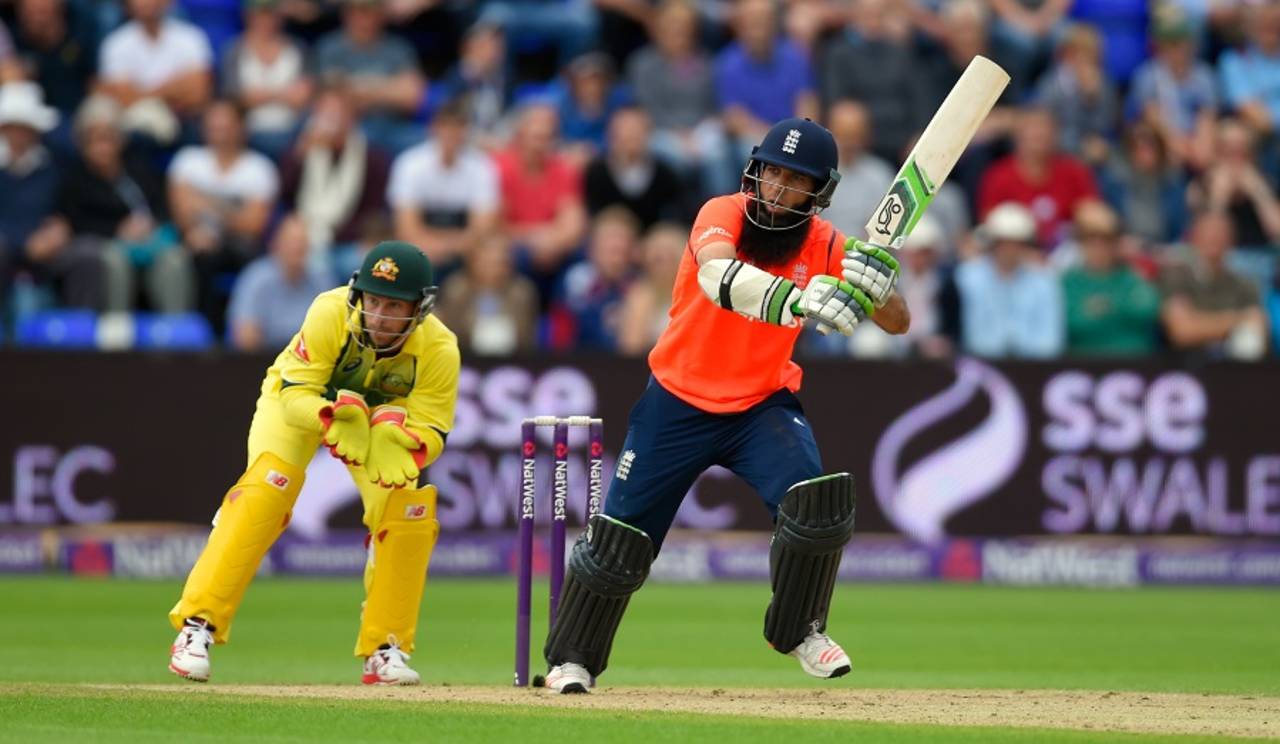Are batting orders more fluid now?
Players with transferable white-ball skills are no longer as easy to fit into old stereotypes
Jon Hotten
16-Nov-2015

Moeen Ali: proof that your place in the order partly determines the way you play • Getty Images
In the first paragraph of George Dobell's wonderful Cricket Monthly story on Moeen Ali, he describes his subject as "an elegant batsman and a soft-spoken man…" I'm not sure how deliberate that was, but a batsman is what Moeen is. Later Dobell outlines some of Moeen's early feats: scoring 195 in a 20-over game as a 14-year-old, signed to Warwickshire at 15, making 68 on his first class debut and then being dropped and so on. His bowling enters the story halfway through.
This is not another piece about the current cricketing life of Moeen as a bowlery-batting, useful, good-egg kinda guy. Instead it's about batting orders, and what they mean to batsmen. Because for most of cricket history, the batting order has defined a player's standing in the world and to the world.
It can confer status, position, security of tenure. It can also define the psyche of its inhabitants. One of the great pieces of contemporary TV punditry (admittedly a small field) came from Steve Harmison, when he said of Ben Stokes, "Put him at No. 8 eight and he'll bat like a No. 8…" It's true that the position can force a player to bat a certain way.
For some years, certainly pre-T20 cricket, a batting order, while nuanced by the players that occupied it, had a blueprint recognised by most. It went something like:
1. Technician
2. Strokemaker
3. Best player
4. Show pony
5. Rising/fading star
6. Allrounder or security blanket
7. Gilchrist clone
2. Strokemaker
3. Best player
4. Show pony
5. Rising/fading star
6. Allrounder or security blanket
7. Gilchrist clone
Ricky Ponting and Vivian Richards believed that the best player should bat at three. Richards treated the crease as his stage, evident from the moment of his entrance, when he would wait for the clamour of the opener's dismissal to quiet before walking slowly to the wicket with a gunslinger's swagger, relishing every eye upon him.
Once the innings was under his command it was conducted at his pace. The former Notts spinner Andy Afford tells a wonderful tale of bowling at Richards as a young man and being instructed firmly by his captain not to utter a word to the champion. Richards was chatting with the wicketkeeper, Bruce French, as Aff waited nervously to purvey his first ball. "Hurry up." he said, before he could stop himself. Richards was actually too angry to hit Aff out of the ground but laid waste to the bowling at the other end, much to the Nottinghamshire captain's chagrin.
Ponting regarded the crease as his office. On arrival he would clear the "rubble" - real and imagined loose turf and dirt - in a wide radius around him, claiming the space as his territory. Having spent the evening beforehand going over the written checklist of his pre-game routine, he was ready to "retaliate first" as he put it in his book At Close Of Play.
Kevin Pietersen, although clearly England's best player during his peak years, resisted a move to three. Four suited his persona and his plan.
Sometimes teams can be better when players refuse to subjugate their own needs for the sake of everyone else
Adam Gilchrist's batting in Australia's Test match team was so powerfully revolutionary that it reinvented the No. 7 spot not just for Australia but for everyone else. Pre-Gilchrist, a specialist wicketkeeper may regularly have batted at eight or nine. Not anymore.
It feels as if a new fluidity is blowing through batting, though, and players with transferable white-ball skills are no longer as easy to fit into old stereotypes. England, in particular, have an odd order, in that they cannot find an opening partner for Cook or a convincing post-Trott No. 3, and they have natural No. 5s batting all the way down to eight.
And we live in an age when (almost) everyone can bat. Jimmy Anderson, who seems to approach the crease with all the joy of a man setting foot in solitary confinement for the first day of a nine-month stint, is a doughty player for a No. 11.
So to Moeen, who has a wonderful Test match hundred scored from No. 7, two ODI tons made as an opener, and a T20I best of 72 not out from No. 3. He has, in 31 innings (from 19 Test matches), appeared at No. 1 twice, No. 2 four times, 11 times at No. 6, No. 7 twice, No. 8 six times, and No. 9 twice.
He told Dobell: "The way I've chosen to look at it is that batting at No. 8 gives you licence to play some shots. If you're batting with the tail, you probably have to farm the strike a bit and look to cash in if the ball is there to be hit. The downside of that is, you're going to nick off a bit more. In an ideal world, I'd probably bat at five or six. Maybe if I prove myself at eight, I'll get the opportunity to move up one day."
Thus speaks an admirable team man, but also a man in search of a place and an identity that fits both his self-image and his talent. Sometimes teams can be better when players refuse to subjugate their own needs for the sake of everyone else. Batting orders have never been simply about numbers.
Jon Hotten blogs here. @theoldbatsman